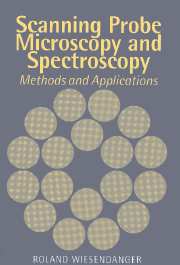Book contents
- Frontmatter
- Contents
- Preface
- List of acronyms
- Introduction
- Part one Experimental methods and theoretical background of scanning probe microscopy and spectroscopy
- Part two Applications of scanning probe microscopy and spectroscopy
- 4 Condensed matter physics
- 5 Chemistry
- 6 Organic material
- 7 Metrology and standards
- 8 Nanotechnology
- References
- Index
8 - Nanotechnology
Published online by Cambridge University Press: 05 October 2010
- Frontmatter
- Contents
- Preface
- List of acronyms
- Introduction
- Part one Experimental methods and theoretical background of scanning probe microscopy and spectroscopy
- Part two Applications of scanning probe microscopy and spectroscopy
- 4 Condensed matter physics
- 5 Chemistry
- 6 Organic material
- 7 Metrology and standards
- 8 Nanotechnology
- References
- Index
Summary
With the increasing degree of miniaturization in microelectronics, we unquestionably become confronted with structures of matter on a scale below 100 nm. The transition from microtechnology (lateral dimensions of 0.1–100 μm) to nanotechnology (lateral dimensions of 0.1–100 nm) requires the ability to fabricate smaller structures as well as the exploration and application of new physical phenomena occurring on the refined scale which becomes comparable to the characteristic lengths associated with the elementary processes in physics (e.g. the electron mean free path). In particular, entering the nanotechnology age involves the following tasks:
nanopositioning and nanocontrol of processes,
nanoprecision machining,
finding natural supersmooth surfaces and/or creating them,
fabrication of nanometer-scale structures,
analysis of nanometer-scale structures,
understanding the physical properties of matter on a nanometer scale,
development of nanometer-scale devices,
finding appropriate architectures for nanometer-scale structures, and
linking the ‘nanoscopic’ to the macroscopic world.
With the invention of STM and related scanning probe methods, we have been equipped in good time with the appropriate tools to attack most of these tasks, and there can be no doubt that STM-based technology and nanotechnology will interact closely in the coming decades.
STM-based technology has enabled us to control the position and motion of arbitrarily small objects down to a sub-Ångström unit scale (section 1.10).
STM and AFM can nowadays routinely be used to control the roughness of surfaces from a millimeter down to the atomic scale.
[…]
- Type
- Chapter
- Information
- Scanning Probe Microscopy and SpectroscopyMethods and Applications, pp. 542 - 580Publisher: Cambridge University PressPrint publication year: 1994
- 3
- Cited by

